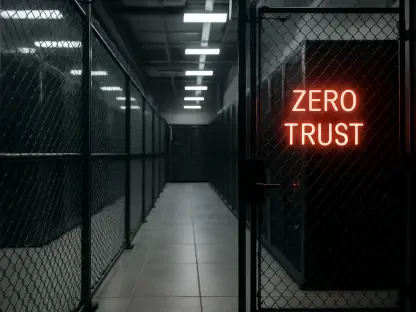In the digital era, the landscape of network security is rapidly changing. Traditional Network Access Control (NAC) systems, long regarded as the cornerstone of network access security, are increasingly perceived as inadequate in addressing contemporary cyber threats. With enterprises embracing hybrid work models and a growing number of connected devices, security measures need to be more dynamic and granular. This shift calls for Universal Zero Trust Network Access (UZTNA)—a modern approach that fortifies network security by embracing the zero-trust framework. This article explores the imperative transition from NAC to UZTNA, uncovering its benefits, complexities, and the path forward for organizations seeking robust security solutions.
The Limitations of Traditional Network Access Control (NAC)
Inadequate Granularity in Access Control
Traditional NAC systems offer broad access once a device is authenticated, failing to provide fine-grained, real-time access control. The zero-trust security model, which UZTNA supports, requires continuous verification based on various parameters such as user identity, device type, and real-time risk posture. NAC’s limited ability to offer precise control means that once a device has been authenticated, it may have almost unrestricted network access. This aspect is a significant security vulnerability, as it does not align with the principle of least privilege, a core tenet of zero trust. In modern network environments, where maintaining stringent control over access levels is crucial, NAC’s broad access permissions fall short.
Given the complex nature of contemporary corporate networks, where employees access sensitive data from multiple devices and locations, the blanket approach of NAC becomes a liability. Organizations must ensure that access controls are dynamic and context-aware, adapting in real-time to the smallest fluctuation in user behavior or device status. However, NAC systems lack the sophisticated algorithms and real-time assessment capabilities required to meet these modern demands, leading to potential security breaches and unauthorized access.
Security Gaps in Modern Threat Landscapes
NAC systems often rely on outdated methods like MAC authentication bypass lists, which are vulnerable to spoofing and other sophisticated attacks. The rise of hybrid and remote work settings necessitates more robust security measures. NAC’s inability to adapt to these changes leads to substantial security gaps. Furthermore, the proliferation of mobile and remote workforces renders NAC’s traditional model less effective. Employees accessing the network from various locations and devices expose vulnerabilities that NAC was never designed to handle. These deficiencies in NAC systems underscore the need for a more advanced solution.
The increasing number of devices interconnected within an organization—including personal smartphones, tablets, and Internet of Things (IoT) gadgets—further complicates the security landscape. Traditional NAC solutions struggle to cope with this unprecedented level of device diversity and connectivity. The static and limited scope of NAC cannot provide the continuous monitoring and adaptive response required to safeguard modern enterprises from dynamic and sophisticated cyber threats.
The Emergence of Universal Zero Trust Network Access (UZTNA)
Granular, Application-Level Access Control
UZTNA revolutionizes access control by implementing a highly granular, application-level approach. Access permissions are determined based on a comprehensive set of parameters, ensuring a higher level of security compared to the broad access management typical of NAC. By integrating user identity, device type, application usage, and real-time risk scores, UZTNA facilitates precise control over who accesses what within the network. This approach significantly reduces the likelihood of unauthorized access, aligning perfectly with the zero-trust principle of always verifying access requests.
One of the critical advantages of this approach is its ability to enforce the principle of least privilege effectively. By evaluating each access request on a case-by-case basis using real-time data, UZTNA can limit access to only the necessary applications and data, thus minimizing potential attack surfaces. This contrasts sharply with NAC’s outdated model, which assumes that a device authenticated once can be trusted indefinitely, overlooking the dynamic nature of modern cyber threats and the ever-evolving risk landscape.
Dynamic Access Adjustments
One of the hallmarks of UZTNA is its ability to dynamically adjust access permissions based on real-time risk assessments. This critical feature ensures that access rights are continually evaluated and adapted to the evolving threat landscape. In contrast to the static nature of NAC, UZTNA’s dynamic access adjustments provide a proactive defense mechanism. When potential threats are detected or the risk posture changes, the system can swiftly modify permissions to mitigate risks. This adaptability is invaluable in maintaining secure operations in an unpredictable cyber environment.
The real-time assessment and response capabilities of UZTNA significantly enhance an organization’s ability to counter sophisticated cyber threats. As the system constantly monitors various risk factors—ranging from unusual user behavior to device integrity—it can preemptively restrict access to prevent potential security breaches. This intelligence-driven adaptability not only ensures a higher level of security but also improves overall network performance by eliminating unauthorized access proactively.
Navigating the Transition: Challenges and Considerations
Hairpin Cloud Routing and Its Implications
The transition to UZTNA is not without challenges. One significant challenge is hairpin cloud routing, where internal network traffic is inefficiently routed through the cloud for enforcement, impacting performance and increasing costs. This can be particularly problematic in high-traffic environments. Over time, improvements in local enforcement mechanisms are expected to mitigate these issues. However, organizations must be prepared for potential performance lags and increased costs during the initial phases of UZTNA implementation. Careful planning and vendor collaboration are essential to navigate this challenge effectively.
Hairpin cloud routing can potentially create latency and bottlenecks, compromising the user experience and aggravating network performance. As organizations gradually transition to UZTNA, they must consider balancing security with performance, ensuring that security measures do not impede operational efficiency. Collaboration with vendors to refine cloud enforcement mechanisms and the gradual implementation of local enforcement can help alleviate these issues, ensuring a seamless and effective transition to UZTNA.
Managing Unmanaged Devices on Wired Networks
Enforcing access control on unmanaged devices across wired networks presents a considerable challenge. Establishing device identity and implementing control measures often requires modifications to existing IP infrastructure, which can be disruptive and complex. Organizations with a significant number of unmanaged devices may face additional hurdles in managing and securing these endpoints. Transitioning to UZTNA necessitates robust strategies for device management, potentially involving infrastructure upgrades and collaboration with technology partners to ensure seamless integration.
Identifying and securely managing a diverse range of unmanaged devices—from personal gadgets to visitor devices—demands meticulous planning and execution. UZTNA’s advanced access control measures can help in preemptively securing these devices by continually evaluating their risk posture. However, organizations must also consider upgrading their existing IP infrastructures to accommodate these enhanced security measures. This transition may involve extensive collaboration with networking experts and hardware providers to ensure a harmonious and uncomplicated integration of UZTNA into their network architecture.
IoT/OT Environment Complexities
IoT and Operational Technology (OT) environments introduce unique challenges in the context of ZTNA. The diversity of proprietary protocols and limited contextual information for risk assessments complicate achieving full ZTNA functionality. Effective UZTNA implementation in these environments often requires vendor collaboration and substantial infrastructure modifications. Organizations must navigate these complexities to ensure that their IoT/OT devices are adequately protected while maintaining operational efficiency.
Given the plethora of devices and sensors operating on various proprietary protocols, achieving comprehensive security coverage remains an intricate task. UZTNA’s fine-grained, real-time access control can mitigate some risks, but integrating these measures into diverse IoT/OT environments is challenging. Organizations must work closely with vendors to develop customized solutions, enabling seamless integration without compromising functional performance. This approach not only bolsters security but also ensures that operational technology continues to function optimally while staying protected from potential cyber threats.
By understanding these challenges and developing strategic plans, organizations can successfully transition to UZTNA, enhancing their overall security posture in today’s complex digital landscape.
Conclusion: Embracing the Future of Secure Network Access
In today’s digital age, the field of network security is evolving rapidly. While traditional Network Access Control (NAC) systems have long been the backbone of network access security, they’re increasingly seen as insufficient against modern cyber threats. With businesses adopting hybrid work environments and an ever-increasing number of connected devices, security strategies must become more adaptable and detailed. This evolving landscape necessitates the adoption of Universal Zero Trust Network Access (UZTNA), an advanced method that strengthens network security by implementing the zero-trust model. UZTNA is designed to assume no device or user is inherently trustworthy, and every access request must be verified.
This article delves into the critical transition from NAC to UZTNA, highlighting its advantages, challenges, and the future direction for organizations aiming to enhance their security frameworks. UZTNA not only addresses the limitations of traditional NAC, but it also offers a more robust security solution by continuously monitoring and validating each access point. By upgrading to UZTNA, companies can better protect their data and networks in this evolving digital landscape.









